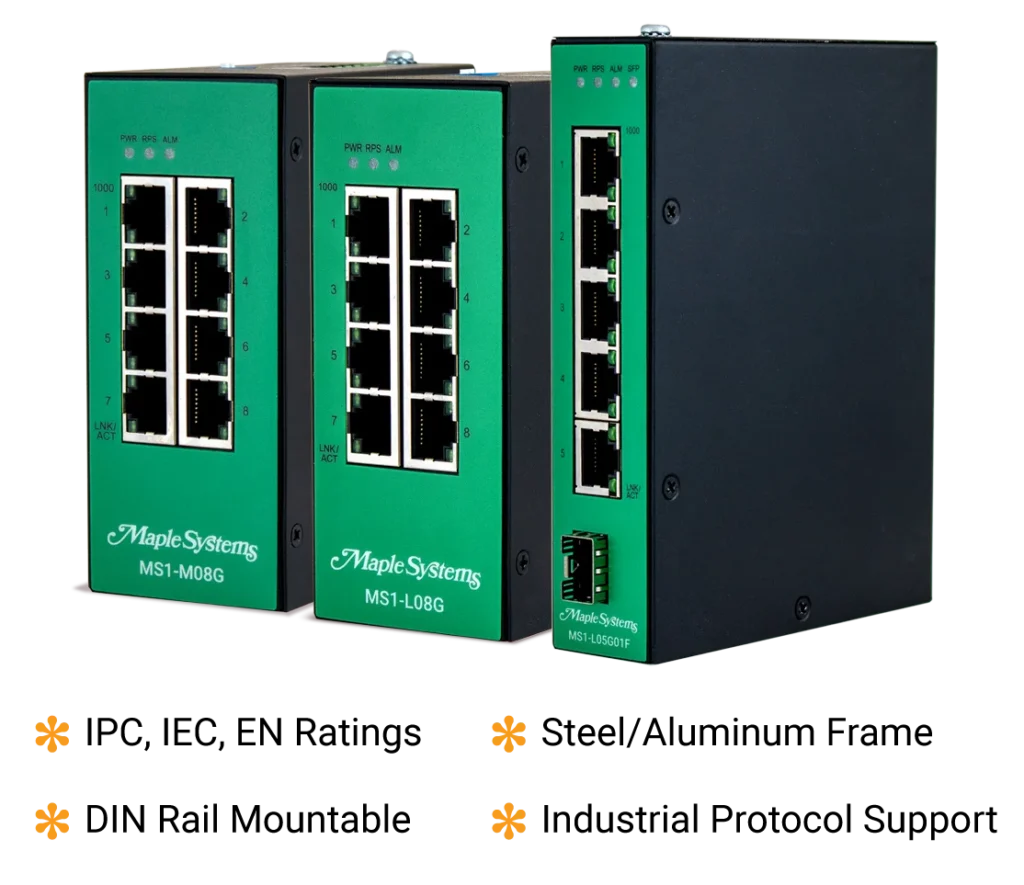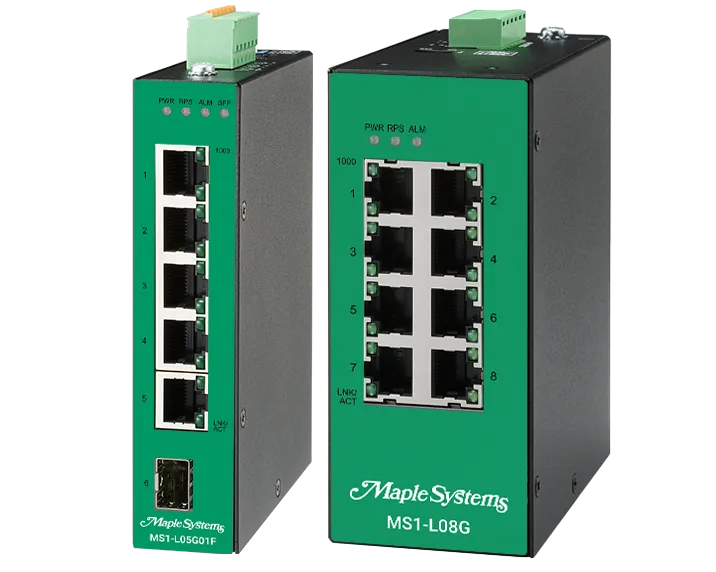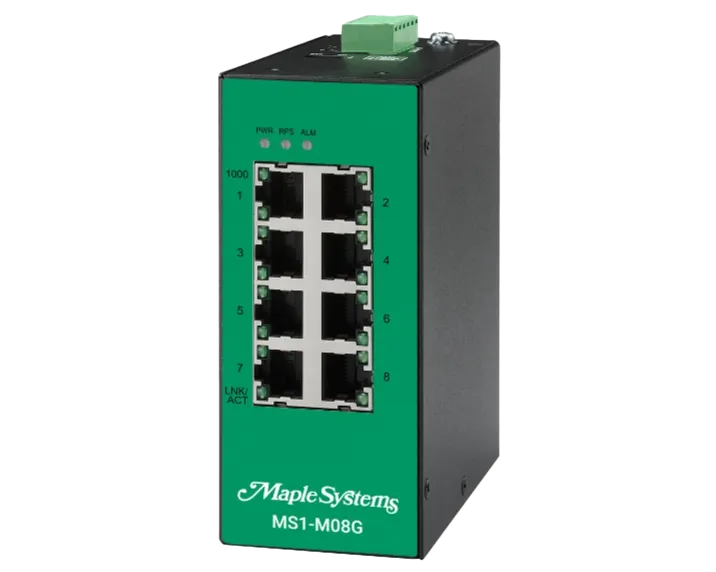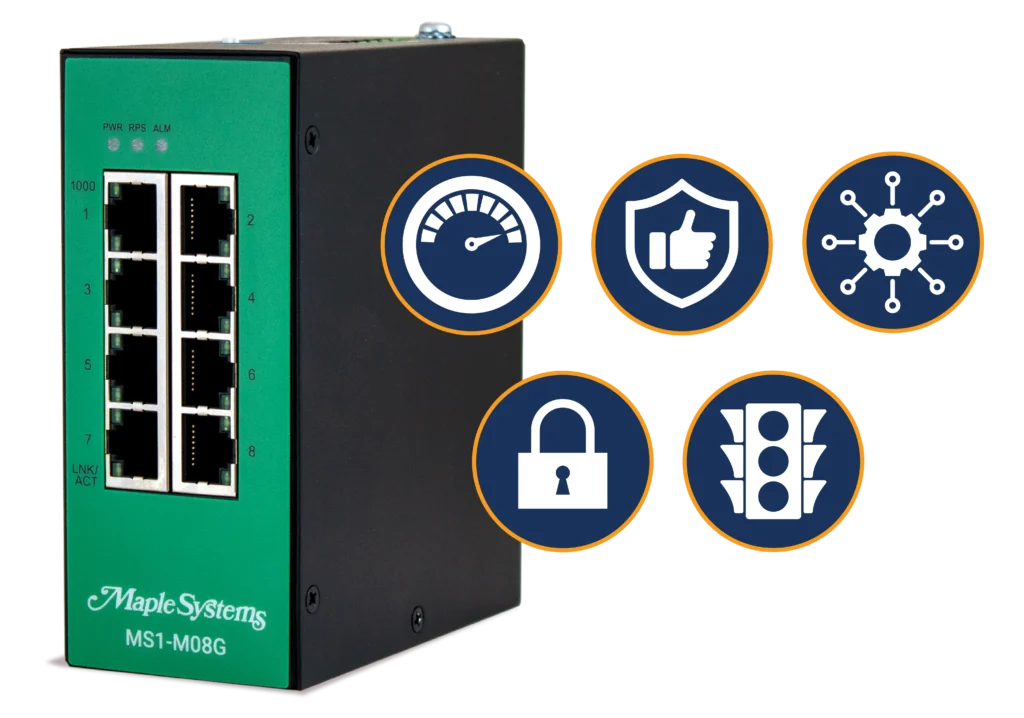What is a managed network switch?
A managed network switch is a device that gives system administrators greater control over every piece of information that travels through their industrial networks. With features to boost security, manage traffic, and improve network performance, they’re a must have for high-end industrial automation and control systems.
A managed network switch is a device system administrators use to maintain exceptional control and monitoring power over their networks. Unlike a regular network switch, a plug-and-play station for adding more devices to simple networks, managed network switches interconnect system devices where speed, security, and reliability are essential. In automated factories, downtime can cause system failures, and system failures can lead to money loss. With managed network switches, system failures are better avoided thanks to improved traffic control, device handling, and security.
What is an industrial managed network switch?
Industrial managed network switches are built to handle the rugged conditions found in factories, power plants, or outdoor enclosures. Unlike standard switches, industrial switches can operate at extreme temperatures, resist dust and vibration, and mount onto DIN rails inside control panels. They often have redundant power inputs to help stay on, fanless cooling for lasting durability, and metal housings for added protection. Supporting industrial protocols like Modbus TCP/IP or Ethernet/IP, these switches are optimized for real-time communication, making them a reliable backbone for systems where uptime is critical.

What are the features of a managed network switch?
Managed network switches are powerful tools that improve visibility and control over how data moves through a system. One of the reasons they’re so powerful is because their features cover nearly everything needed to control dataflow. This makes it easier to stay on top of a system’s performance, security, and stability—especially with a fully managed switch.
Network management
Managed switches simplify monitoring and configuring a network from a central location. Each switch has its own IP address, allowing admins to log in through a command-line interface (CLI) or web graphical user interface (GUI) like Maple Systems’ MapleLink or MapleLink-Lite. With these programs, system admins can view connected devices, check port statuses, run diagnostics, and push updates.
- SNMP, or simple network management protocol, is a tool used to monitor and manage network devices. Managed switches can create SNMP traps, real-time alerts triggered by specific events that help identify and address issues.
- Modbus TCP server support lets a managed switch share key data, like port status and traffic info, with industrial systems like supervisory control and data acquisition (SCADA) systems or human-machine interfaces (HMIs).
- Auto provisioning uses a configuration text file created by engineers that local switches read to obtain parameters and settings. When a value in the file changes, the system automatically updates all connected devices. This improves scalability by allowing consistent configurations to be reused across different environments.
- Syslog is a logging system that sends real-time messages from the switch to a central syslog server. It records important events to help admins troubleshoot issues, monitor network health, and keep track of network access.
Traffic control
In industrial automation, real-time performance matters. If networks just allowed any data to flow through, it would compromise security and bog down traffic. Managed switches allow system admins to control how traffic flows through the network to ensure that only specific data is let in. Modern switches can even prioritize which data enters first.
- IQoS, or Industrial Quality of Service, helps network switches prioritize critical data, like control commands or machine signals, so they get through without delay.
- 802.1Q VLAN is a networking standard for creating separate virtual networks within a single physical network by tagging data packets. This lets switches know which VLAN packets belong to, keeping traffic from different groups isolated even though they share the same cables. This also assists with VLAN passthrough and trunking.
- Port mirroring duplicates network traffic from a specific port and send it to other ports, typically connected to an IDS (Intrusion Detection System) and an IPS (Intrusion Prevention System), for monitoring and analysis.
- MAC addressing gives every network device a unique name so that managed switches can identify, track, and control which devices send or receive data. This helps block unknown hardware or lock ports to specific machines.
Security
Managed switches provide more protection against unauthorized access and rogue devices. With flexible security features, system admins can control who gets on the network and what they can do once connected.
- Port-based 802.1X authentication ensures only approved devices can connect to a network. When a device plugs into a switch port, the switch won’t let any data through until the device proves its identity. This requires an active directory domain with a network policy server (NPS) enabled.
- Access Control Lists are security rules that restrict which IP addresses or MAC addresses can access a switch’s management interfaces (GUI or CLI) from specific ports, limiting who can configure the switch.
- IP Source Guard prevents unauthorized devices from disrupting the network. It can block rogue DHCP servers, inspect and protect ARP tables from poisoning attacks, and enforce bindings between IP addresses, MAC addresses, VLANs, and physical ports, ensuring only trusted devices communicate on the network.
- SNMP v3 is the most secure version of SNMP. Unlike earlier versions (v1 and v2c) that used basic community strings like passwords, SNMP v3 adds authentication, access control, and optional encryption.
Reliability and performance
In high-stakes environments like manufacturing or utilities, downtime isn’t an option. Managed switches can detect issues and reroute traffic automatically, reducing the risk of a total network outage.
- Loop Detection automatically identifies network loops and blocks the affected port to prevent broadcast storms or traffic overload. Once the loop is resolved, the port can either recover automatically or be manually unblocked through the switch’s web GUI or CLI.
- RSTP and STP, or rapid spanning tree protocol and spanning tree protocol, are safety nets for a network that keep data from getting stuck in endless loops. In a network with multiple switches and connections, loops can accidentally happen and cause major slowdowns or crashes. RSTP and STP prevent this.
- ERPS, or Ethernet Ring Protection Switching, is designed for ring-shaped network topologies, where devices are connected in a loop. To prevent broadcast storms and looping traffic, ERPS keeps one segment of the ring intentionally blocked. If a failure occurs elsewhere in the loop, ERPS quickly reactivates the blocked segment to maintain communication without downtime.
- Code redundancy is a built-in safety backup of a switch’s configuration and firmware, so nothing gets lost during reboots or updates. Think of it like having a spare copy of the settings and software stored on a device.
What’s the difference between a lite and fully managed network switch?
Lite-managed network switches have the same basic hardware as fully managed switches, but they streamline down to only the most essential control and security capabilities. They’re a great middle ground for systems that don’t need all the bells and whistles of a fully managed switch but need more than plug-and-play simplicity. Think of them as powerful hubs that offer VLAN support, SNMP monitoring, and basic traffic management.
Fully managed switches are for complex environments where system admins require total control over every bit, byte, and data package. Fully managed switches offer advanced traffic shaping, port mirroring, link aggregation, and stronger security tools like port-based 802.1X and SNMP v3. They also give admins full access to command-line configuration, detailed logging, and remote management capabilities across large or segmented networks. Some features include:
- Dual homing lets a device or switch connect to two separate network paths or switches at the same time. This creates a backup connection, so if one path fails, the other keeps networks up and running without interruption.
- LACP, or link aggregation control protocol, combines multiple network ports into one high-bandwidth connection. Instead of relying on one cable between devices, LACP bundles two or more links together for faster speeds and built-in backup.
- MSTP, or multiple spanning tree protocol, is a network protocol that helps manage complex networks with lots of VLANs by creating multiple spanning tree instances. Instead of having just one spanning tree for the entire network, MSTP lets system admins group VLANs into separate “trees,” each with its own optimized path.
- Static trunking is a method system admins use to manually set up a network link between two switches. This link carries traffic for multiple VLANs at once, improving control and stability. It’s the opposite of dynamic trunking, which automatically negotiates the connection.
Maple Systems managed network switches
A Maple Systems Managed Network Switch can easily face the hardships of the factory floor. They are DIN rail mountable and backed by IP, IEC, and EN ratings for proven resistance against dust, debris, shocks, and vibrations. They are also built with industrial-grade components, good thermal conductivity, and enclosed in an IP30 metal case, making them resistant to electromagnetic interference, electrostatic discharge, power surges, over-voltage, over-current, and reverse polarity.
Maple Systems switches also support all the configuration, security, reliability features listed in this article, like access control lists, STP/RSTP, SNMP v3, and much more. With a Maple Systems managed network switch, system admins have the control, speed, and security they need to confidently manage the biggest and most intricate industrial networks.


Learn more with Maple Systems
Need help building a new network or programming your first PLC? Maple Systems has a library of technical and educational resources to help. View our support pages for tutorials, tech notes, sample projects, and more.
Contact us
Contact our sales team for pricing, availability, and support. Email [email protected] or call (425) 745-3229.
About the Author

